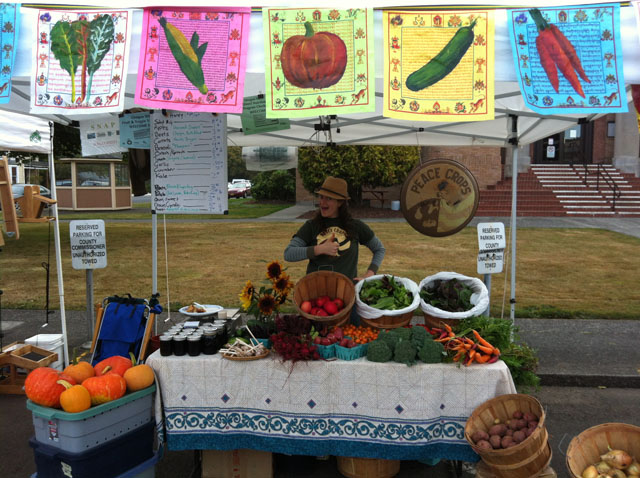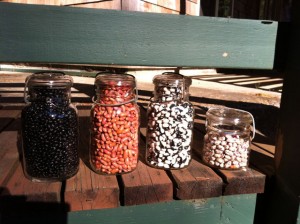 The end of the farming season has arrived. Or, more precisely, the end of the farmers’ market season. Here’s a picture of Emily at our stand in Tillamook. At both the Manzanita and Tillamook farmers’ markets, we had somewhat slow final weeks… most of the tourists are gone, and the locals can’t entirely make up the difference. One thing that helped keep revenues up was the honey; nearly a third of gross sales has been honey in the last three weeks. It makes me even more excited about beekeeping than before, if that were possible, and we’re planning on expanding to 6 or 7 hives next spring.
The end of the farming season has arrived. Or, more precisely, the end of the farmers’ market season. Here’s a picture of Emily at our stand in Tillamook. At both the Manzanita and Tillamook farmers’ markets, we had somewhat slow final weeks… most of the tourists are gone, and the locals can’t entirely make up the difference. One thing that helped keep revenues up was the honey; nearly a third of gross sales has been honey in the last three weeks. It makes me even more excited about beekeeping than before, if that were possible, and we’re planning on expanding to 6 or 7 hives next spring.
Even though the market season is over, “farming” really isn’t. We still deliver to the restaurant accounts (things like pumpkins, potatoes, and spinach), and we have some overwinter crops that still need occasional tending: broccoli, carrots, chard, beets. The cold here is far less severe than most places in the US due to the moderating influence of the ocean, so it doesn’t freeze more than a few weeks per year and we rarely see temperatures below 20°F. This means that all the root crops store just fine in the ground!
For all the other beds, though, we pulled up the dry remains of the summer’s growth. Some of our friends came out for a work-cation last week and helped us quite a bit with clearing, broadforking the soil, and planting the cover crop. This year, we’re trying Crimson Clover as our cover crop; it comes highly recommended. It’s happy in moist climates, adds nitrogen, and it also has a root system that is easy to turn under in the spring but will hold soil during the winter rains.
 I was also able to get a few patches of winter wheat planted, which I’m pretty excited about. I have no idea if it will be successful or even practical, but that’s what experimenting is all about. One of my big tests this season was dry beans. Legumes are really good for the soil, as they fix nitrogen, and a significant portion of your acreage should be planted in them if you want a sustainable system. The bad news is that they are not a high-value crop, at least not the way we are farming, so we were unsure of how it would all work out: were they labor intensive to harvest? Would they produce much per bed? As it turns out, harvesting is easy: wait until the plants dry up, pick them all and throw them in a bin, and stomp them like crazy. The beans thresh out easily, and can be winnowed form the chaff by pouring back and forth between buckets in a stiff breeze. Result? About 6 pound of dry beans per bed. Here’s a few different varieties we grew, a portion of the 20 pounds of beans from this year. That sounds like a lot, but we can do better: production by skilled biointensive growers on high-quality soils can reach up to 25lb per bed. And we can definitely eat more beans: if you eat the USRDA of beans, it works out to 60 pounds per year! Magical fruit indeed. Selling the beans would be completely pointless as a business proposition, but eating them is quite satisfying.
I was also able to get a few patches of winter wheat planted, which I’m pretty excited about. I have no idea if it will be successful or even practical, but that’s what experimenting is all about. One of my big tests this season was dry beans. Legumes are really good for the soil, as they fix nitrogen, and a significant portion of your acreage should be planted in them if you want a sustainable system. The bad news is that they are not a high-value crop, at least not the way we are farming, so we were unsure of how it would all work out: were they labor intensive to harvest? Would they produce much per bed? As it turns out, harvesting is easy: wait until the plants dry up, pick them all and throw them in a bin, and stomp them like crazy. The beans thresh out easily, and can be winnowed form the chaff by pouring back and forth between buckets in a stiff breeze. Result? About 6 pound of dry beans per bed. Here’s a few different varieties we grew, a portion of the 20 pounds of beans from this year. That sounds like a lot, but we can do better: production by skilled biointensive growers on high-quality soils can reach up to 25lb per bed. And we can definitely eat more beans: if you eat the USRDA of beans, it works out to 60 pounds per year! Magical fruit indeed. Selling the beans would be completely pointless as a business proposition, but eating them is quite satisfying.
One of the things I look forward to this winter is the chance to analyze all the sales and production data we’ve collected. I will post some of the results in the next few weeks as I get around to compiling them. Last years’ results were really useful for planning this year, and I am sure that with two years’ worth of data, we can be that much more efficient in our planning for 2013.



One Response to Emily’s last stand